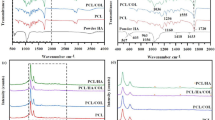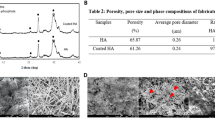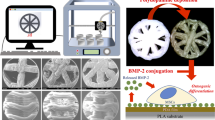Abstract
Production of a 3D bone construct with high-yield differentiated cells using an appropriate cell source provides a reliable strategy for different purposes such as therapeutic screening of the drugs. Although adult stem cells can be a good source, their application is limited due to invasive procedure of their isolation and low yield of differentiation. Patient-specific human-induced pluripotent stem cells (hiPSCs) can be an alternative due to their long-term self-renewal capacity and pluripotency after several passages, resolving the requirement of a large number of progenitor cells. In this study, a new biphasic 3D-printed collagen-coated HA/β-TCP scaffold was fabricated to provide a 3D environment for the cells. The fabricated scaffolds were characterized by the 3D laser scanning digital microscopy, X-ray diffraction, Fourier transform infrared spectroscopy, and mechanical test. Then, the osteogenesis potential of the hiPSC-seeded scaffolds was investigated compared to the buccal fat pad stem cell (BFPSC)-seeded scaffolds through in vitro and in vivo studies. In vitro results demonstrated up-regulated expressions of osteogenesis-related genes of RUNX2, ALP, BMP2, and COL1 compared to the BFPSC-seeded scaffolds. In vivo results on calvarial defects in the rats confirmed a higher bone formation in the hiPSC-seeded scaffolds compared to the BFPSC-seeded groups. The immunofluorescence assay also showed higher expression levels of collagen I and osteocalcin proteins in the hiPSC-seeded scaffolds. It can be concluded that using the hiPSC-seeded scaffolds can lead to a high yield of osteogenesis, and the hiPSCs can be used as a superior stem cell source compared to BFPSCs for bone-like construct bioengineering.









Similar content being viewed by others
References
Ahangari G, Amirabad LM, Mozafari S, Majeidi A, Deilami GD (2013) Investigation of 5-HT3A receptor gene expression in peripheral blood mononuclear cells of individuals who had been exposed to air pollution. Inflamm Allergy Drug Targets 12(6):433–438. https://doi.org/10.2174/18715281113129990041
Autefage H, Briand-Mésange F, Cazalbou S, Drouet C, Fourmy D, Gonçalvès S, Salles J-P, Combes C, Swider P, Rey C (2009) Adsorption and release of BMP-2 on nanocrystalline apatite-coated and uncoated hydroxyapatite/β-tricalcium phosphate porous ceramics. J Biomed Mater Res B Appl Biomater 91B(2):706–715. https://doi.org/10.1002/jbm.b.31447
Ayala-Peña VB, Scolaro LA, Santillán GE (2013) ATP and UTP stimulate bone morphogenetic protein-2,-4 and -5 gene expression and mineralization by rat primary osteoblasts involving PI3K/AKT pathway. Exp Cell Res 319(13):2028–2036. https://doi.org/10.1016/j.yexcr.2013.05.006
Bandyopadhyay A, Bernard S, Xue W, Bose S (2006) Calcium phosphate-based resorbable ceramics: influence of MgO, ZnO, and SiO2 dopants. J Am Ceram Soc 89(9):2675–2688. https://doi.org/10.1111/j.1551-2916.2006.01207.x
Banerjee SS, Tarafder S, Davies NM, Bandyopadhyay A, Bose S (2010) Understanding the influence of MgO and SrO binary doping on the mechanical and biological properties of β-TCP ceramics. Acta Biomater 6(10):4167–4174. https://doi.org/10.1016/j.actbio.2010.05.012
Bilousova G, Jun DH, King KB, De Langhe S, Chick WS, Torchia EC, Chow KS, Klemm DJ, Roop DR, Majka SM (2011) Osteoblasts derived from induced pluripotent stem cells form calcified structures in scaffolds both in vitro and in vivo. Stem cells 29(2):206–216. https://doi.org/10.1002/stem.566
Chen Y, Yu Q, Xu C-B (2017) A convenient method for quantifying collagen fibers in atherosclerotic lesions by ImageJ software. Int J Clin Exp Med 10:14904–14910
Cordell JM, Vogl ML, Wagoner Johnson AJ (2009) The influence of micropore size on the mechanical properties of bulk hydroxyapatite and hydroxyapatite scaffolds. J Mech Behav Biomed Mater 2(5):560–570. https://doi.org/10.1016/j.jmbbm.2009.01.009
De Boer J, Wang HJ, Van Blitterswijk C (2004) Effects of Wnt signaling on proliferation and differentiation of human mesenchymal stem cells. Tissue Eng 10(3–4):393–401. https://doi.org/10.1089/107632704323061753
Di Benedetto A, Gigante I, Colucci S, Grano M (2013) Periodontal disease: linking the primary inflammation to bone loss. In Clinical and Developmental Immunology, Vol. 2013. Hindawi Limited. London, UK. https://doi.org/10.1155/2013/503754
Di Lullo GA, Sweeney SM, Körkkö J, Ala-Kokko L, San Antonio JD (2002) Mapping the ligand-binding sites and disease-associated mutations on the most abundant protein in the human, type I collagen. J Biol Chem 277(6):4223–4231. https://doi.org/10.1074/jbc.M110709200
Diederichs S, Tuan RS (2014) Functional comparison of human-induced pluripotent stem cell-derived mesenchymal cells and bone marrow-derived mesenchymal stromal cells from the same donor. Stem Cells and Development 23(14):1594–1610. https://doi.org/10.1089/scd.2013.0477
Egusa H, Kayashima H, Miura J, Uraguchi S, Wang F, Okawa H, Sasaki J-I, Saeki M, Matsumoto T, Yatani H (2014) Comparative analysis of mouse-induced pluripotent stem cells and mesenchymal stem cells during osteogenic differentiation in vitro. Stem Cells and Development 23(18):2156–2169. https://doi.org/10.1089/scd.2013.0344
Egusa H, Sonoyama W, Nishimura M, Atsuta I, Akiyama K (2012) Stem cells in dentistry - part II: clinical applications. J Prosthodont Res 56(4):229–248. https://doi.org/10.1016/j.jpor.2012.10.001
Esfahanizadeh N, Daneshparvar p, Takzaree N, Rezvan M, Daneshparvar N (2019) Histologic evaluation of the bone regeneration capacities of Bio-Oss and MinerOss X in rabbit calvarial defects. Int J Periodontics Restorative Dent 39(6):e219–e227. https://doi.org/10.11607/prd.4181
Farré-Guasch E, Martí-Pagès C, Hernández-Alfaro F, Klein-Nulend J, Casals N (2010) Buccal fat pad, an oral access source of human adipose stem cells with potential for osteochondral tissue engineering: an in vitro study. Tissue Engineering - Part C: Methods 16(5):1083–1094. https://doi.org/10.1089/ten.tec.2009.0487
Gomes KDN, Alves APNN, Dutra PGP, De Barros Viana GS (2017) Doxycycline induces bone repair and changes in Wnt signalling. International Journal of Oral Science 9(3):158–166. https://doi.org/10.1038/ijos.2017.28
Grskovic M, Javaherian A, Strulovici B, Daley GQ (2011) Induced pluripotent stem cells — opportunities for disease modelling and drug discovery. Nat Rev Drug Discovery 10(12):915–929. https://doi.org/10.1038/nrd3577
He Y, Liu W, Guan L, Chen J, Duan L, Jia Z, Huang J, Li W, Liu J, Xiong J, Liu L, Wang D (2018) A 3D-printed PLCL scaffold coated with collagen type I and its biocompatibility. Biomed Res Int 2018:5147156–5147156. https://doi.org/10.1155/2018/5147156
Hollister SJ (2005) Porous scaffold design for tissue engineering. In Nature Materials Vol. 4, Issue 7. Nature Publishing Group. pp. 518–524 https://doi.org/10.1038/nmat1421
Huang K, Hou J, Gu Z, Wu J (2019) Egg-white-/eggshell-based biomimetic hybrid hydrogels for bone regeneration. ACS Biomaterials Science and Engineering 5(10):5384–5391. https://doi.org/10.1021/acsbiomaterials.9b00990
Humphries JD, Byron A, Humphries MJ (2006) Integrin ligands at a glance. J Cell Sci 119(19):3901–3903. https://doi.org/10.1242/jcs.03098
Hutmacher DW, Schantz JT, Lam CXF, Tan KC, Lim TC (2007) State of the art and future directions of scaffold-based bone engineering from a biomaterials perspective. Journal of Tissue Engineering and Regenerative Medicine 1(4):245–260. https://doi.org/10.1002/term.24
Hyun JS, Levi B, Montoro D, Hu S, Sun N, Wan D, Lee M, Nag D, Nelson ER, Connolly A, Wu J, Gurtner GC, Longaker MT (2012) In Vivo Directed differentiation of pluripotent stem cells to bone lineage and repair of a skeletal defect. J Surg Res 172(2):202. https://doi.org/10.1016/j.jss.2011.11.271
Itskovitz-Eldor J, Schuldiner M, Karsenti D, Eden A, Yanuka O, Amit M, Soreq H, Benvenisty N (2000) Differentiation of human embryonic stem cells into embryoid bodies compromising the three embryonic germ layers. Molecular Medicine (Cambridge, Mass). 6(2):88–95. https://doi.org/10.1007/bf03401776
Jensen EC (2013) Quantitative analysis of histological staining and fluorescence using ImageJ. In Anatomical Record Vol. 296, Issue 3. Anat Rec (Hoboken) https://doi.org/10.1002/ar.22641
Jeon OH, Panicker LM, Lu Q, Chae JJ, Feldman RA, Elisseeff JH (2016) Human iPSC-derived osteoblasts and osteoclasts together promote bone regeneration in 3D biomaterials. Sci Rep 6:1–11. https://doi.org/10.1038/srep26761
Kang Y, Kim S, Bishop J, Khademhosseini A, Yang Y (2012) The osteogenic differentiation of human bone marrow MSCs on HUVEC-derived ECM and β-TCP scaffold. Biomaterials 33(29):6998–7007. https://doi.org/10.1016/j.biomaterials.2012.06.061
Kelly KF, Ng DY, Jayakumaran G, Wood GA, Koide H, Doble BW (2011) β-catenin enhances Oct-4 activity and reinforces pluripotency through a TCF-independent mechanism. Cell Stem Cell 8(2):214–227. https://doi.org/10.1016/j.stem.2010.12.010
Khojasteh A, Sadeghi N (2016) Application of buccal fat pad-derived stem cells in combination with autogenous iliac bone graft in the treatment of maxillomandibular atrophy: a preliminary human study. Int J Oral Maxillofac Surg 45(7):864–871. https://doi.org/10.1016/j.ijom.2016.01.003
Kolf CM, Cho E, Tuan RS (2007) Mesenchymal stromal cells. Biology of adult mesenchymal stem cells: regulation of niche, self-renewal and differentiation. In Arthritis Research and Therapy 9(1) https://doi.org/10.1186/ar2116
Komori T (2010) Regulation of osteoblast differentiation by runx2. Adv Exp Med Biol 658:43–49. https://doi.org/10.1007/978-1-4419-1050-9_5
Lee JS, Suarez-Gonzalez D, Murphy WL (2011) Mineral coatings for temporally controlled delivery of multiple proteins. Adv Mater 23(37):4279–4284. https://doi.org/10.1002/adma.201100060
Levi B, Hyun JS, Montoro DT, Lo DD, Chan CKF, Hu S, Sun N, Lee M, Grova M, Connolly AJ, Wu JC, Gurtner GC, Weissman IL, Wan DC, Longaker MT (2012) In vivo directed differentiation of pluripotent stem cells for skeletal regeneration. Proc Natl Acad Sci 109(50):20379–20384. https://doi.org/10.1073/pnas.1218052109
Li F, Bronson S, Niyibizi C (2010) Derivation of murine induced pluripotent stem cells (iPS) and assessment of their differentiation toward osteogenic lineage. J Cell Biochem 109(4):643–652. https://doi.org/10.1002/jcb.22440
Liu C, Oikonomopoulos A, Sayed N, Wu JC (2018) Modeling human diseases with induced pluripotent stem cells: from 2D to 3D and beyond. Development (Cambridge), 145(5). https://doi.org/10.1242/dev.156166
Loh QL, Choong C (2013) Three-dimensional scaffolds for tissue engineering applications: role of porosity and pore size. Tissue Eng Part B Rev 19(6):485–502. https://doi.org/10.1089/ten.teb.2012.0437
Matsuno T, Hashimoto Y, Adachi S, Omata K, Yoshitaka Y, Ozeki Y, Umezu Y, Tabata Y, Nakamura M, Satoh T (2008) Preparation of injectable 3D-formed β-tricalcium phosphate bead/alginate composite for bone tissue engineering. Dent Mater J 27(6):827–834. https://doi.org/10.4012/dmj.27.827
Mohammadi Amirabad L, Massumi M, Shamsara M, Shabani I, Amari A, Mossahebi Mohammadi M, Hosseinzadeh S, Vakilian S, Steinbach SK, Khorramizadeh MR, Soleimani M, Barzin J (2017) Enhanced cardiac differentiation of human cardiovascular disease patient-specific induced pluripotent stem cells by applying unidirectional electrical pulses using aligned electroactive nanofibrous scaffolds. ACS Appl Mater Interfaces 9(8):6849–6864. https://doi.org/10.1021/acsami.6b15271
Murakami S, Miyaji H, Nishida E, Kawamoto K, Miyata S, Takita H, Akasaka T, Fugetsu B, Iwanaga T, Hongo H, Amizuka N, Sugaya T, Kawanami M (2017) Dose effects of beta-tricalcium phosphate nanoparticles on biocompatibility and bone conductive ability of three-dimensional collagen scaffolds. Dent Mater J 36(5):573–583. https://doi.org/10.4012/dmj.2016-295
Nandakumar A, Barradas A, de Boer J, Moroni L, van Blitterswijk C, Habibovic P (2013) Combining technologies to create bioactive hybrid scaffolds for bone tissue engineering. Biomatter 3(2):e23705. https://doi.org/10.4161/biom.23705
Pirosa A, Gottardi R, Alexander PG, Tuan RS (2018) Engineering in-vitro stem cell-based vascularized bone models for drug screening and predictive toxicology. In Stem Cell Research and Therapy (Vol. 9, Issue 1, p.112). BioMed Central Ltd https://doi.org/10.1186/s13287-018-0847-8
Rajaei B, Shamsara M, Amirabad LM, Massumi M, Sanati MH (2017) Pancreatic endoderm-derived from diabetic patient-specific induced pluripotent stem cell generates glucose-responsive insulin-secreting cells. J Cell Physiol 232(10):2616–2625. https://doi.org/10.1002/jcp.25459
Ruijter JM, Ramakers C, Hoogaars WMH, Karlen Y, Bakker O, van den hoff, M. J. B., & Moorman, A. F. M. (2009) Amplification efficiency: Linking baseline and bias in the analysis of quantitative PCR data. Nucleic Acids Res 37(6):e45. https://doi.org/10.1093/nar/gkp045
Salgado AJ, Coutinho OP, Reis RL (2004) Bone tissue engineering: state of the art and future trends. Macromol Biosci 4(8):743–765. https://doi.org/10.1002/mabi.200400026
Santos CFL, Silva AP, Lopes L, Pires I, Correia IJ (2012) Design and production of sintered β-tricalcium phosphate 3D scaffolds for bone tissue regeneration. Mater Sci Eng, C 32(5):1293–1298. https://doi.org/10.1016/j.msec.2012.04.010
Shahabi S, Najafi F, Majdabadi A, Hooshmand T, Haghbin Nazarpak M, Karimi B, Fatemi SM (2014) Effect of gamma irradiation on structural and biological properties of a PLGA-PEG-hydroxyapatite composite. Scientific World Journal, 2014. https://doi.org/10.1155/2014/420616
Shahini A, Yazdimamaghani M, Walker KJ, Eastman MA, Hatami-Marbini H, Smith BJ, Ricci JL, Madihally SV, Vashaee D, Tayebi L (2013) 3D conductive nanocomposite scaffold for bone tissue engineering. Int J Nanomed 9(1):167–181. https://doi.org/10.2147/IJN.S54668
Shih YRV, Hwang Y, Phadke A, Kang H, Hwang NS, Caro EJ, Nguyen S, Siu M, Theodorakis EA, Gianneschi NC, Vecchio KS, Chien S, Lee OK, Varghese S (2014) Calcium phosphate-bearing matrices induce osteogenic differentiation of stem cells through adenosine signaling. Proc Natl Acad Sci USA 111(3):990–995. https://doi.org/10.1073/pnas.1321717111
Shiraishi T, Sumita Y, Wakamastu Y, Nagai K, Asahina I (2012) Formation of engineered bone with adipose stromal cells from buccal fat pad. J Dent Res 91(6):592–597. https://doi.org/10.1177/0022034512445633
Takebe T, Zhang B, Radisic M (2017) Synergistic Engineering: Organoids Meet Organs-on-a-Chip. Cell Stem Cell 21(3):297–300. https://doi.org/10.1016/j.stem.2017.08.016
Tarafder S, Balla VK, Davies NM, Bandyopadhyay A, Bose S (2013) Microwave-sintered 3D printed tricalcium phosphate scaffolds for bone tissue engineering. Journal of Tissue Engineering and Regenerative Medicine 7(8):631–641. https://doi.org/10.1002/term.555
Turnbull G, Clarke J, Picard F, Riches P, Jia L, Han F, Li B, Shu W (2018) 3D bioactive composite scaffolds for bone tissue engineering. In Bioactive Materials (Vol. 3, Issue 3). KeAi Communications Co pp. 278–314 https://doi.org/10.1016/j.bioactmat.2017.10.001
Wang P, Liu X, Zhao L, Weir MD, Sun J, Chen W, Man Y, Xu HHK (2015) Bone tissue engineering via human induced pluripotent, umbilical cord and bone marrow mesenchymal stem cells in rat cranium. Acta Biomater 18:236–248. https://doi.org/10.1016/j.actbio.2015.02.011
Williams DF, David F, European Society for Biomaterials (1987) Definitions in biomaterials : proceedings of a consensus conference of the European Society for Biomaterials, Elsevier, Chester, England, 3–5 March 1986
Yeong WY, Chua CK, Leong KF, Chandrasekaran M (2004) Rapid prototyping in tissue engineering: challenges and potential. Trends in Biotechnology 22(12):643–652. https://doi.org/10.1016/j.tibtech.2004.10.004
Yu X, Wang L, Peng F, Jiang X, Xia Z, Huang J, Rowe D, Wei M (2013) The effect of fresh bone marrow cells on reconstruction of mouse calvarial defect combined with calvarial osteoprogenitor cells and collagen-apatite scaffold. Journal of Tissue Engineering and Regenerative Medicine 7(12):974–983. https://doi.org/10.1002/term.1490
Yu X, Xia Z, Wang L, Peng F, Jiang X, Huang J, Rowe D, Wei M (2012) Controlling the structural organization of regenerated bone by tailoring tissue engineering scaffold architecture. J Mater Chem 22(19):9721–9730. https://doi.org/10.1039/c2jm30332a
Yuan H, Kurashina K, de Bruijn JD, Li Y, de Groot K, Zhang X (1999) A preliminary study on osteoinduction of two kinds of calcium phosphate ceramics. Biomaterials 20(19):1799–1806. https://doi.org/10.1016/s0142-9612(99)00075-7
Zhao C, Ikeya M (2018) Generation and Applications of Induced Pluripotent Stem Cell-Derived Mesenchymal Stem Cells. In Stem Cells International (Vol. 2018). Hindawi Limited. https://doi.org/10.1155/2018/9601623
Zhou Y, Gu Z, Liu J, Huang K, Liu G, Wu J (2020) Arginine based poly (ester amide)/ hyaluronic acid hybrid hydrogels for bone tissue Engineering. Carbohyd Polym 230:115640. https://doi.org/10.1016/j.carbpol.2019.115640
Acknowledgments
The authors would like to thank the staff and officials in the Research Institute for Dental Sciences, Shahid Beheshti University of Medical Sciences, Tehran, Iran.
Funding
This study was financially supported by the School of Advanced Technologies in Medicine, Shahid Beheshti University of Medical Sciences, Tehran, Iran.
Author information
Authors and Affiliations
Corresponding author
Ethics declarations
Conflict of interest
The authors declare that they have no conflict of interest.
Ethical approval
All the procedures performed in the studies involving the animals and human were in accordance with the ethical standards of the Iran’s National Committee for Ethics in Biomedical Research. The animal experiments conducted in this study were approved by the Animal Research and Care Committee, the Faculty of Veterinary Medicine, University of Tehran (IBR-UT139615). Ethical approval for obtaining the samples from the humans was given by the Ethics Committee of the Shahid Beheshti University of Medical Sciences (IR.SBMU.RETECH.REC.1396.1301).
Informed consent
In this study, the BFPSCs were harvested from the healthy donors presenting to the Clinic of Oral and Maxillofacial Surgery, Dental School of Shahid Beheshti University of Medical Sciences in Tehran, Iran. An informed written consent was obtained from all the donors.
Additional information
Publisher’s Note
Springer Nature remains neutral with regard to jurisdictional claims in published maps and institutional affiliations.
Rights and permissions
About this article
Cite this article
Hashemi, S., Mohammadi Amirabad, L., Farzad-Mohajeri, S. et al. Comparison of osteogenic differentiation potential of induced pluripotent stem cells and buccal fat pad stem cells on 3D-printed HA/β-TCP collagen-coated scaffolds. Cell Tissue Res 384, 403–421 (2021). https://doi.org/10.1007/s00441-020-03374-8
Received:
Accepted:
Published:
Issue Date:
DOI: https://doi.org/10.1007/s00441-020-03374-8




